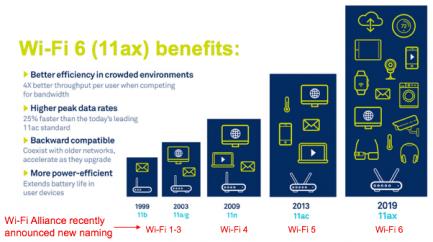In the world of communications, the industry fairly quickly got a handle on a naming convention for cellular technology generations that us non-communication geeks could understand – 2G, 3G, 4G and now 5G, (though some of us could never quite understand the difference between 4G and LTE, at least as those terms are widely and no doubt inexpertly used). This is a nice steady progression, easy for us uncultured masses to remember, with no confusing affixes.

Bluetooth has from the beginning followed a largely similar convention in generation naming from 1.0 up to current BT 5 which drops the ”.0” on the name, not coincidentally aligning numerically with the latest cellular standard. There is a sub-generation of 4.0 (at least initially), known widely as BLE (Bluetooth Low Energy) but we generally understand that this is a low-energy variant on the underlying standard.
Wi-Fi on the other hand soldiered on in geekdom, oblivious to the needs of the masses, by sticking a bewildering array of postfixes on the root 802.11 standard name. I guarantee that no-one in the general public would have any idea what you were talking about if you asked them about say 802.11n, whereas many would profess at least some familiarity with 5G, if with the name only. The Wi-Fi Alliance recognized this wasn’t great for marketing and has recently switched to a much easier naming convention, at least for the most recent generations.
For the newer generations of the standard, 802.11n becomes Wi-Fi 4, 802.11ac becomes Wi-Fi 5 and 802.11ax becomes Wi-Fi 6. For 802.11a/b/g I hear differing stories. Fortune magazine says that these names won’t change. Another contact says (plausibly) that these will be known as Wi-Fi generations 1, 2 and 3. Now isn’t that easier to understand? You may not know what they are but all of us can understand that as you progress from Wi-Fi 1 to Wi-Fi 6, you get better technology at each stage, for which you are prepared to shell out more money (see, that’s marketing).
We’re a bit more sophisticated than that, so what are 4-6? Wi-Fi 4 (aka the “n” version) supports transmission rates 5-6 times faster than the Wi-Fi 3 version, higher reliability and supports MIMO (multi-input, multi-output) where multiple antennae at receiver and/or transmitter further boost reliability and transmission rates.
Wi-Fi 5 (aka the “ac” version), introduced in 2014, increases rates by a factor 2 or more and more efficiently uses bandwidth so more users can be served at speed in one network. However, more efficient usage is only in the downlink. So you can all watch cat videos with minimal buffering but the network bogs down if you all want to share with friends. Wi-Fi 6 (aka the “ax” version), expected to be ratified by the end of 2019, goes one step further, packing multiple users more effectively in both downlink and uplink, serving an expected 4X improvement in throughput in high user density environments (think of a stadium). It also offers a 25% improvement in peak data rate.
So Wi-Fi generation naming is now understandable and mostly aligned with cellular and Bluetooth naming. There’s an apparent disconnect in that the latest Wi-Fi is Wi-Fi 6, whereas cellular is at 5G and Bluetooth is at BT5. But the official Wi-Fi 6 is a year away so perhaps numeric synchronization isn’t too far off. When we’re checking out phones or other devices, we should reasonably soon be able to look for all communications to be at level “N” (maybe 6?) no matter what the underlying technology. That will make life a lot simpler, certainly for me.
I have to thank Franz Dugand, Sales and Mktg Director for Connectivity at CEVA for these insights. Naturally CEVA has a wide range of Wi-Fi IPs across these standards, including Wi-Fi 6, ranging from low-power to high-performance to multi-gig rates. CEVA have been in the Wi-Fi core licensing business since 2002 so they’re very well known and established in the space. You can learn more about their RivieraWaves Wi-Fi platforms HERE.
Share this post via:





Comments
3 Replies to “Wi-Fi Standards Simplified”
You must register or log in to view/post comments.